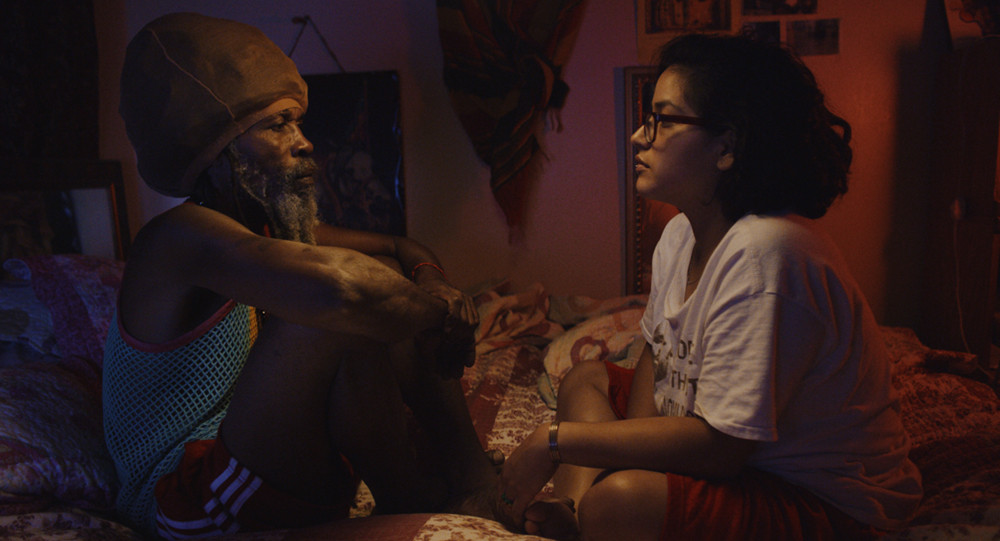[ad_1]
I’ve been thinking about Adam Khalil and Bayley Sweitzer’s film Empty Metal (2018) ever since I saw it over a year ago, at a screening last Halloween at the Berkeley Art Museum and Pacific Film Archive. The movie is, in a word, disquieting. Empty Metal is finally seeing its premiere theatrical run at the Anthology Film Archives in New York through December 11. It revolves around an assassination plot: telepathic revolutionaries and a Brooklyn noise band conspire to avenge the murders of Trayvon Martin, Eric Garner, and Michael Brown. A filmic meditation on the apocalypse and political violence, it couldn’t be timelier amid a political moment marked by ecological destruction, a rise in international fascism, and popular protest around the world.
The film begins with a caricature of a Brooklyn band called Alien. Its three members are listless and frustrated with their direction, and their record label messed up their new album. Quick cuts juxtapose depictions of their trivial woes and scenes of police brutality at protests. We are then introduced to a group of revolutionaries with three leaders—a Rastafarian, a Native American activist, and a European mystic. The league communicates telepathically, and is bound together across time and place by a shared political duty. After what would be the band’s final show, an unnamed younger revolutionary working with the trio approaches Rose, Alien’s vocalist. The revolutionary puts her forehead to Rose’s, transferring knowledge to her. Viewers do not know what she shares, but the singer’s immediate shift to a withdrawn disposition suggests something deeply unsettling. Whatever was communicated ends the band’s struggle for a sense of purpose: they are going to become assassins.
The plot has three targets, one for each of the band’s three members. The names of the targets are bleeped out and their faces are blurred, but their identities are fairly easy to deduce and are known to anyone who even cursorily follows the news. All three are racist murderers who were either acquitted or never indicted; their alleged crimes mobilized social movements. In a way, their identities do not matter: they embody greater structural violence. The plan is born of the trio’s frustration with the inefficacy of nonviolent methods.
“Why the fuck is he still alive?” one band member asks, referring to a character based on Daniel Pantaleo, the NYPD officer who strangled Eric Garner. This is a question about justice, and about the vulnerability of some communities to necessary and premature death. Throughout, the film questions the idea that nonviolent tactics are the only appropriate responses to state violence. The state’s monopoly on force strengthensthe stability of its power. As an off-screen narrator offers musings on the apocalypse, viewers are invited to imagine how gratifying the end of this world might be, should it bring down the powerful with it.
Courtesy Factory 25.
“For us, the end of the world came a long time ago,” states the voiceover, frankly and unfeelingly. The speaker defines “apocalypse” as an uncovering of truth, and the end of the world as a matter of perspective. These abstract musings invite viewers to interpret the assassination plot as bringing about the end of the world, or a world. The narrator alludes to the ways that Anthropocentric modernity has been globally apocalyptic for Indigenous and other racialized peoples. The coming end of the world is in fact the end of a society that privileges white humanity. It will be the apocalypse of the apocalypse, the end of the centuries–long systematic destruction, enslavement, and forced dispersal of non-white worlds in service of a thriving white future. But as satisfying as it may be to imagine, it is a pyrrhic victory that comes at the cost of everyone’s survival, from Indigenous water protectors to profit-obsessed oil barons. The band members find themselves in a state of paranoia and exile after participating in the plot. The end of the world is subjective, affecting different populations in unequal ways and at unequal rates. Their effort to precipitate apocalyptic conditions completely uproots their own personal senses of safety and self.
The scenes of the successful assassinations are not spectacular: the killings are precise and surgical. Perhaps their understated representation is meant to mimic the banality with which racist murders callously looped on the news and social media. Each target is killed in his home: one is shot while painting his living room, another drinks a poisoned six-pack of beer from his refrigerator, and the third is strangled. These deaths do not bring about the apocalypse, and we don’t see a popular movement galvanized by them. So what was the purpose?
Many have argued that it is impossible to represent violent acts without promoting them. In The Art of Cruelty: A Reckoning (2011), Maggie Nelson critiques “model[s] of shaming-us-into-action-by-unmasking-the-truth-of-our-actions,” which “cannot hold a candle to our capacity to assimilate horrific images, and to justify or shrug off horrific behavior.” Khalil and Sweitzer are not using violence to glorify vigilantism, but carefully considering the possibilities—and consequences—of its use. The film leaves the question of the impact of the assassinations unresolved, even though they are extensively considered and rationalized by its characters: violence is presented as a reasoned and methodical political strategy that aims to be, as Frantz Fanon puts it, meaningful and self-actualizing. Even so, it is jarring to see the taboo of violence against hegemonic power being broken. We have seen countless images of violence against the oppressed, often in the name of raising awareness. This was famously the case in Dana Schutz’s gruesome and controversial Open Casket, an abstracted painting of Emmett Till at his funeral, included in the 2017 Whitney Biennial. Mia Locks, the biennial’s co-curator, defended its inclusion as an honoring of Till’s mother’s wish to show his mutilated face at the funeral and “not [let] Till’s death be forgotten.” Why are there so many fewer depictions of acts of vengeance and revenge and fighting back against the powerful? Empty Metal fearlessly takes up this much needed counter-narrative.
[ad_2]
Source link


